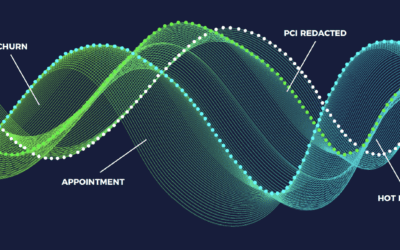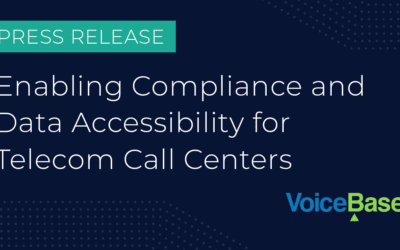Listening to the true Voice of the Customer (VoC) has never been as critical and demanding as it is today. As each consumer’s needs are different, understanding each one is vital to a great customer experience (CX). Creating powerful customer experiences requires your team to track and analyze every conversation. As a result, more contact centers are heavily investing in tools to monitor the Voice of the Customer to help them keep up with high demands and expectations and increase sales and customer loyalty.
With voice analytics, you can automatically categorize, tag, monitor and score 100% of your customer interactions. Voice analytics lets you see what your customers are thinking and saying and view data across your entire CX ecosystem.
What Is Voice of the Customer (VoC)?
Voice of the Customer refers to how an organization collects customer insights and analyzes data from customer communications to deliver better customer experience, products and services. It involves capturing data on customer expectations and preferences and often elicits feedback directly through surveys.
For years, companies have been listening to customer calls to better understand their wants and needs. For instance, in a study conducted by Salesforce, 64% of marketing leaders say, in light of changing customer expectations, their companies are increasing their focus on building a consistent experience across all channels. Any growing and successful business knows collecting and taking action from the Voice of the Customer is a fundamental principle.
Why Does It Matter?
Successful Voice of the Customer programs create better products and increase customer loyalty. They also help you provide better service and quickly understand the customer experience. Using insights collected from recorded calls, you can listen to your customers’ wants and needs while simultaneously gathering information about how your employees interact with consumers daily. By pairing the Voice of the Customer with speech analytics, you can expect positive results such as:
- Reduction in customer churn: Happy customers are loyal customers. By getting a sense of how a customer feels with each call center interaction through speech analytics, your business can tweak its strategies to achieve more positive interactions. Pairing this data with direct feedback from the consumer becomes a powerful tool to improve the customer experience.
- Increased efficiency: With comprehensive customer data, you’re empowered to reduce average handle times and improve your first-call resolution rate. It allows you to track employee performance to identify opportunities for training and improvement. Through improved internal processes, you’ll streamline operations.
- Capitalized opportunities: Tagged keywords and other valuable metrics let you identify new trends in customer wants and needs. This data uncovers opportunities for new products or services, which allows you to more accurately pinpoint and provide what consumers are searching for from their preferred brands — like yours.
- Reduced expenses: By understanding why your customers call and resolving their most pressing issues, you’ll reduce your call volume over time. Data and interviews from customers will help you improve products, processes and services for employees and customers alike, letting you cut costs and improve your bottom line.
- Improved return on investment (ROI): As you learn more about your customers, you can better identify areas to cross-sell and upsell solutions. By retaining more consumers, you’ll preserve your current revenue streams and maximize your average client’s lifetime value.
Why Implement Speech Analytics to Listen to the True Voice of the Customer?
Understanding the true Voice of the Customer through AI-powered speech analytics is a must for any company drowning in phone calls, emails, audio and social media posts. Consumers act quickly, and organizations must act quicker. A study conducted by Oracle states:
- Seventy-nine percent of consumers have their complaints about poor customer experience ignored even after sharing them with the company.
- Eighty-six percent of consumers will spend more money for an improved customer experience.
- Eighty-nine percent of consumers began doing business with a competitor following a poor experience.
- Fifty percent of consumers will stop doing business with a brand that doesn’t respond to a question within one week.
With VoiceBase’s omnichannel products, you can liberate your data, take action and deliver powerful results for your organization. Our products can analyze your calls, identify the caller’s sentiment and automatically tag keywords and trends.
Questions That Prompt Voice of the Customer Data
Collecting active feedback is a central tenet of a successful VoC program. Active feedback methods, including customer surveys, customer interviews and focus groups, let you hear from your clients and find out how your call center or brand is doing. Automated call analytics, combined with unstructured data from open-ended interview questions, is invaluable. These customer responses can be analyzed for common keywords, helping you learn exactly what clients want and need from your company.
You can gain valuable data by asking your customers the following questions.
What Made You Choose Us?
Hearing what your customers love about you helps you play to your strengths in future marketing, sales calls and strategic decisions. For example, suppose your patrons love that they get a live person every time they call. In that case, it’s probably not a good idea to add a laundry list of automated answering prompts to route customers to the right representative. Keeping live representatives on the line also offers more opportunities for employee training, enabling your workers to give clients the best service and support possible.
If your consumers consider your products to have better value or lower cost than your competitors’ offerings, you can incorporate those benefits into your next advertising campaign. Emphasize these elements in your marketing materials — the value your current consumers get from your business will likely appeal to the same wants and needs that potential leads have. When people look to a specific industry or business for services or goods, they’re often seeking to meet a common need.
Understanding why your loyal customers chose you in the first place lets you gain new clients who share similar values and continue the practices and services that drive customer retention.
What Comes to Mind When You Think About Us?
This question can also help you identify your brand’s key differentiators. Your customers’ free-wheeling responses will give you some raw data on their immediate associations with and reactions to your business’s marketing campaigns. You’ll learn how your brand messages or call interactions make people feel. This data can help you avert unwanted brand associations by identifying trends in customer perceptions and readjusting your consumer outreach tactics to shift negative perspectives.
When you’re managing a crisis or implementing a complete rebrand, your customers’ unfiltered thoughts and feelings are incredibly powerful. You can monitor changes in brand perceptions as your situation develops. You’ll know if your crisis management strategies are working or if your rebrand is effective. You’ll also know your actions are successful when you identify an increase in positive responses.
How Can We Improve Your Experience?
Loyal customers earn your business more revenue. In fact, 57% of consumers say they spend more money with brands they’re loyal to. Additionally, members of brand loyalty programs generate 12% to 18% more incremental revenue growth annually for the businesses they patronize than non-members. Implementing a loyalty program with rewards and discounts alongside your other efforts to encourage customer retention could prove promising.
While it’s impossible to implement every customer’s feedback and suggestions, the answers to this question provide valuable data. Through keyword recognition and other analytical information, you can identify the most requested products, services and general improvements. You can then cross-reference this information with your customer relationship data to determine what your most loyal customers want to see. Making improvements that cater to your highest revenue generators will have the most significant long-term effects.
Who Is a Competitor You’ve Considered and Why Did You Consider Using Them?
Out of all the competitor research and mapping your company conducts to scope out the market, the companies your actual customers weigh against yours are your biggest targets. Asking customers to talk about their decision process and name competitors tells you who you’re up against. VoC keyword tracking can help you identify patterns so you can determine who your biggest competition is.
Asking this question can produce surprising data. Sometimes, customers use your products and services alongside a product in a completely different sector. They also could have seriously considered doing business with an up-and-coming company you haven’t heard of yet. This customer-prompted data lets you get ahead of emerging competitors and identify opportunities to expand into new markets.
You’ll also hear about some of your competitors’ offerings that could sway your current or prospective customers away. Maybe other companies have a lower price, more functionality or a higher level of customer service. These data points help your business identify and address weaknesses with improved offerings.
Would You Recommend Us to a Friend?
Customers only advocate for the services they love. People risk their reputations when they make recommendations, and they typically don’t promote products or services that didn’t meet their expectations. If your customers are your biggest fans, you’ll gain future clients through word-of-mouth marketing. Even when customers don’t share their recommendations, knowing whether they would pass on your information gives you a gauge of their loyalty and satisfaction.
Best Practices for Implementing Voice of the Customer Feedback
VoiceBase makes it fast and easy to collect and analyze VoC data. Through speech-to-text transcripts, keyword tagging, call categorization, customer behavior predictions, customer sentiment analysis and call trend statistics, you have a wealth of direct and indirect customer feedback. Once you have a baseline for where you’re excelling and where you need to improve, you can do a lot with your VoC analytics. As you develop improvements, data trends will indicate whether they’re succeeding.
How can you use your customer feedback data to its full potential? Follow these steps to have an increased chance of success:
1. Gather Feedback Across Channels
The first step to using customer feedback is getting the right insights. It involves talking to the right customers, whether those are the most or the least satisfied. You must also prompt the most valuable information by asking specific questions. Only ask questions you plan to act on. That way, you respect your and your customers’ time.
Next, find the right point in the customer journey to ask these questions. You might send them out right after a consumer uses a new service or after a sales prospect doesn’t pan out. It’s also important to collect feedback from all channels where you interact with patrons. This allows you to build a truly seamless customer experience and account for clients who favor specific channels.
2. Make Your Case With Data and Reporting
To make even a small-scale change, you need significant time and monetary investments. You also need buy-in from other decision-makers and departments. Data unites teams behind concrete, actionable goals. To argue your case, organize the data you’ve collected to demonstrate your current benchmarks. If you use VoiceBase, you can pull a wealth of valuable reports to help you communicate with all your decision-makers. Once you’ve established a baseline, your team can discuss your weak areas and talk about which metrics they want to improve.
3. Collaborate Interdepartmentally
The data you collect in the call center affects your entire corporation. While much of your customer feedback will go directly toward improving your customer care, a lot of it concerns other departments and decision-makers throughout your organization.
If your customers suggest a brand-new product, the research and development team would be in charge of making those ideas a reality. If your customers complain about the sales process, the sales team can use that specific feedback to make the experience smoother. Your customer service and call center employees are the first to hear about consumer trends, preferences and complaints that the rest of your company can act on.
4. Use Employee and Customer Data to Make Changes
VoiceBase gives you in-depth Voice of the Customer insights and also tracks employee performance. With information about which employees talk over callers and other key performance indicators, you can improve CX by helping your employees grow. Identify each worker’s weaknesses and customize training to help them provide world-class service. With data about customer sentiment combined with feedback from interviews, you can set metrics-based goals for improvement.
As you implement changes, track your customer and employee data to see how each change affects outcomes.
What Channels Can You Use to Collect Insights From the Voice of the Customer?
Organizations have transitioned to omnichannel options for contact to meet their customer base’s needs. Letting people engage with your brand via the channel they prefer is the first step to improving customer experience. The next step is making sure you can monitor and manage the rich analytics from each of these channels: calls, text messages, emails, social media platforms and even help support platforms such as Zendesk, Salesforce and ServiceNow.
Through VoiceBase’s AI-powered speech analytics, collecting valuable insights from the true Voice of the Customer has never been easier! Are you ready to act and reveal your customer’s journey to unlock invaluable business data? Get your free voice analytics demo to start today.


